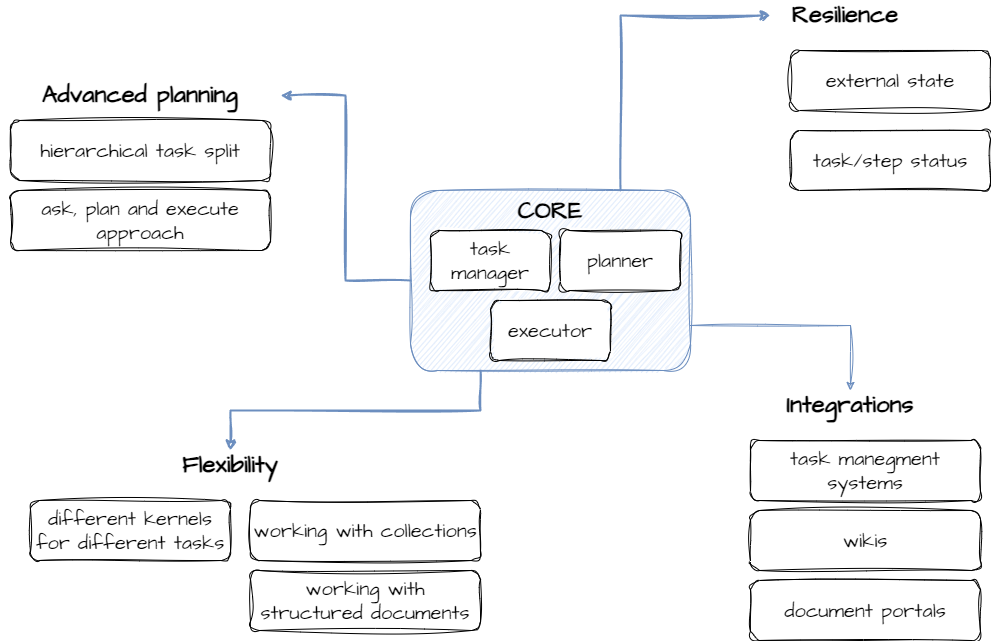Consider this as part 3 of the “Sequential Planner” series: part 1, part 2.
IdeaPermalink
Imagine having unlimited access to remote mid and junior-level knowledge workers. The only limitation? They don’t use Zoom. However:
- They are proficient with Jira and Confluence.
- They are available 24/7.
- They meticulously track their work and validate outcomes.
- They seek assistance when needed.
- … and much more.
Interaction ScenarioPermalink
Here’s an illustrative interaction scenario:
- A user converses with a manager agent (MA) to define a task.
- The MA logs the task in Jira and assigns it to the appropriate worker agent (WA).
- The WA drafts a strategy to accomplish the task, seeking clarifications or supplementary documents if necessary. This plan might manifest as sub-tasks within Jira.
- Once the plan is set, the WA commences its execution, continually updating the status of each sub-task.
- After completing all sub-tasks, the MA conducts a verification/validation. If all criteria are met, the status of the primary task is marked as done.
Current State of Agent DevelopmentPermalink
SimplePermalink
Agents are often perceived as mere remote procedure calls rather than entities capable of planning and execution. Sometimes, they’re even externally orchestrated (e.g., check agentprotocol).
PlannersPermalink
To grasp the limitations of current planners and potential improvements, refer to part 1 and part 2.
ReasoningPermalink
CoT, ToT, GoT – these methods focus predominantly on reasoning, not on collaborative task resolution. Nonetheless, they can certainly serve as low-level approaches.
Main Hint: Workflow Engines AnalogyPermalink
Indeed, workflows are repetitive processes. However, they offer a prime analogy for understanding task execution. Explore platforms like Camunda, Nintex, Azure Logic Apps, etc. Envision task setup akin to configuring a workflow, accounting for:
- Internal variables.
- Sub-processes.
- Updates to external systems.
- And more. The task execution can be likened to running such a workflow – but just once.
Missing IngredientsPermalink
There are four pivotal components currently absent in state-of-the-art agent developments:
- An innovative task planning methodology, incorporating hierarchical task decomposition and the ask-plan-execute strategy.
- Flexibility concerning multiple kernels/LLMS and intricate internal data types (entities, collections).
- Resilience regarding external task and sub-task states and statuses.
- Seamless integration with task management systems, wikis, and document portals.

Agent CorePermalink
Three ModulesPermalink
The core functionality of an agent can be divided into three modules:
- Manager:
- Engages with users or high-level systems.
- Primarily aims to draft a detailed task description.
- Planner:
- Utilizes the detailed task description to devise an execution plan.
- Can seek further information from the manager or report issues if the task plan is unfeasible due to insufficient skills or data.
- Delivers a search tree alongside the execution plan, offering insights to the executor in case of execution issues.
- The plan is uploaded to the task management system (TMS).
- Executor:
- Carries out the plan either autonomously or with the assistance of simple agents.
- Updates task statuses in the TMS during execution. Some artifacts may also be generated in wikis, portals, or code repositories.
Planning ExecutionPermalink
Approach the agent as you would a junior developer: don’t anticipate exhaustive domain knowledge or flawless execution. Allow the agent to outline its approach to achieving the desired outcome (see Hierarchical task split). A hierarchical planner can either produce an executable plan or one of two errors: lack of functions or lack of information. These inadequacies can be interpreted as calls for assistance.
Tasks, Wikis, etc.Permalink
While the conventional approach (except for MemGPT) retains the entire execution log in context, the proposition here is to use a wiki and/or task description to house intermediary data. The motivations are:
- It’s pivotal for parallel execution and multiple agents working on sub-tasks.
- Agent activities are easily traceable, thanks to standard task management solutions and wikis.
For this to be feasible, agents must understand tasks, sub-tasks, their interrelations, statuses, etc., as well as the structure of the wiki. This understanding is essential as different teams manage projects in varied ways.
Future WorkPermalink
The way forward is clear: develop the Core for Workforce Agents.



